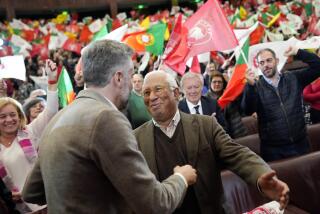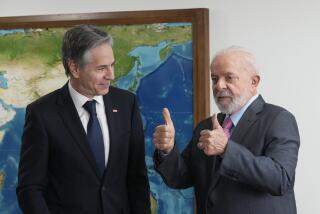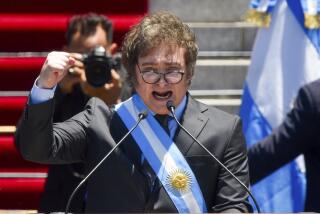A Troubled Economy’s Reckoning Hour Arrives
- Share via
WASHINGTON — Earlier this month, Brazilian voters reelected President Fernando Henrique Cardoso despite the certain knowledge that he was determined to make their economic lives tougher. The hemisphere’s economic future may be riding on Brazil’s short-term misery.
Before the voting, public opinion polls revealed the stunning paradox: as expectations about the Brazilian currency’s exchange rate worsened, support for Cardoso increased. Voters’ deeper fear was of his main opponent, a labor leader universally known as Lula. Were he to become president, a populist policy of rising government expenditures surely would follow, reigniting the inflation that Cardoso, as finance minister, had staunched when he introduced the Real Plan in 1994. That achievement was the reason he won his first term.
The real, Brazil’s currency, has been under attack by currency speculators since about August. In part, this stems from the financial crises in East Asia and Russia, which have prompted investors to flee from most emerging markets in search of less risky places to put their money. But only in part. The Brazilian currency was targeted because it is overvalued by as much as 20%; the public-sector deficit is more than 7% of gross domestic product, and the deficit in the current account of the balance of payments is growing to a dangerous level. In addition to these economic ills, there is little party discipline in the Brazilian legislature, which fed considerable skepticism, both inside and outside the country, that the problems would even be addressed. They were not in Cardoso’s first four years, largely because the president spent much of his last year of office lobbying the population and the Congress to change the constitution so he could run for a second term.
Since August, however, the country’s leaders have displayed a determination, almost regardless of its short-term cost, to prevent an abrupt devaluation of their currency. In so doing, they were ever mindful of Mexico’s recent experience, when a small devaluation in the peso got out of control and led to a deep depression. The Brazilians’ objective was to get through the election, then introduce the fiscal and related reforms that were absent earlier, and find some means in the interim to change investor expectations. That, if it worked, would buy time for an orderly correction of the exchange rate.
The policy has been economically terrifying. Brazil, since August, has used about $30 billion of foreign-exchange reserves and raised real interest rates on government debt to a business-stifling 40% to prop up the currency. Such interest rates cannot last long without crippling the country. The prospects were dire enough to overcome the country’s long history of suspicion of the International Monetary Fund.
On Oct. 8, in a joint statement, the IMF promised support in exchange for a number of Brazilian actions. The government committed itself to front-load budgetary reductions in 1999 and stabilize the ratio of public debt to GDP by the year 2000. Brazil made other promises, including reform of its social security system, its tax structure and the labor market. Under normal circumstances, even talk of such reforms with the IMF would be politically explosive--suicidal, in fact. But the threat to the nation’s economic health makes this an extraordinary time.
The idea is to avoid the kind of bailout that become unavoidable in Mexico, East Asia and Russia and instead reassure market players by preventive action to avert a crash. Unlike a typical IMF program, the intent is to take action before the collapse. The expectation is that the IMF can come up with about $30 billion, and that additional funds might be provided by the central banks of a number of countries. When Brazil’s remaining foreign reserves of more than $40 billion are added, the total would be more than $70 billion, enough, everyone hopes, to convince market players that Brazil can and will hold its exchange rate.
There is no guarantee that the plan will work. After all, the original $75 billion of Brazil’s reserves did not impede attacks on the real. There is no assurance, either, that the reforms Cardoso will introduce will be accepted by the Congress, since they are quite controversial. With the United States struggling with its own versions of reforming Social Security and the tax system, Americans can empathize with the Brazilians’ dread of radical change.
But Cardoso will be acting from a position of strength. Cardoso was able to avoid a runoff because he won an absolute majority of the votes in the first round. Yet, there will be runoffs in gubernatorial elections in some of Brazil’s most populous states, and their outcomes will provide evidence of how much continuing support Cardoso enjoys. Cardoso is confident enough to have announced that he will send his reform proposals to the Congress on Oct. 20. The runoffs take place Oct. 25.
There will be plenty of criticism of the Brazil-IMF approach, because it will result in a contraction, not an expansion, of the economy. It is important to keep in mind, however, that a big reason for Brazil’s current troubles is that the government has been spending beyond its means. The crushingly high interest rates cannot come down unless there is some budget discipline. Cardoso was reelected because the conviction inside Brazil was that the cost would be considerably higher if no action were taken.
Indeed. Brazil is the world’s ninth-largest economy. It contains a sophisticated, first-world industrial plant, centered mainly around Sao Paulo, alongside a degree of poverty that is obsessively third or even fourth world in its dimensions. Using data from the Inter-American Development Bank, more than 40% of the population lives in poverty, which means that they are unable to satisfy basic food and nonfood needs. The most affluent 10% of Brazilian households receive 51% of total income, while the poorest 60% account for 16%.
The majority of the Brazilian population simply cannot afford another hit in their earnings. Yet, this is what is in store for them. If they are able to contain a sharp devaluation now, the economic decline can be modest. If they cannot, the odds are high that the economy would go into a tailspin for a year or more. Cardoso was reelected because he is trusted, undoubtedly more so than any Brazilian president of recent decades.
Much rides on the success of the Brazilian program. Brazil might not be in its current precarious condition had there been no contagion from Asia. Brazil, however, is also a potential carrier, since its collapse would resonate across Latin America, even back to Asia, and probably would not spare the United States. Will the Brazilian program succeed? I rate the probability that it will at 60%.
More to Read
Sign up for Essential California
The most important California stories and recommendations in your inbox every morning.
You may occasionally receive promotional content from the Los Angeles Times.













